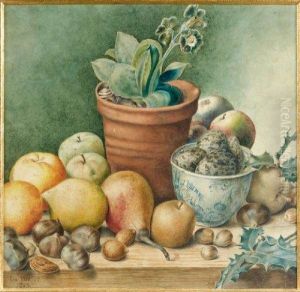Jan Jacobusz De Vos Paintings
Jan Jacobusz de Vos was a Dutch Golden Age painter, primarily known for his still-life and genre paintings. Born in 1593 in Amsterdam, de Vos lived and worked during a period of great wealth and cultural achievement in the Netherlands, which is reflected in the rich details of his artwork. While not as widely recognized as some of his contemporaries like Rembrandt or Vermeer, de Vos contributed to the era's artistic developments with his own unique style and subjects.
De Vos's artistic career was largely focused on still-life paintings, a genre that was gaining significant popularity in the Dutch Republic during the 17th century. His works often featured arrangements of flowers, game, and other objects that were rich in symbolism and carefully composed to convey a sense of order and harmony. De Vos's use of color and light demonstrated his skill in capturing the texture and materiality of the objects he portrayed.
In addition to still lifes, de Vos also painted genre scenes, depicting everyday life in the Netherlands. These works provide a glimpse into the social and cultural aspects of Dutch society at the time. His paintings often included detailed interiors and figures engaged in domestic activities, which were admired for their narrative quality and attention to detail.
Throughout his career, Jan Jacobusz de Vos exhibited a mastery of technique and an ability to imbue his subjects with a sense of realism and vitality. His work was well-received during his lifetime, and he was an active member of the artist's community in Amsterdam. However, his reputation did not endure as prominently as some of his peers after his death in 1641, resulting in a lesser degree of recognition in the centuries that followed.
Despite this, Jan Jacobusz de Vos's paintings are still appreciated today by art historians and collectors for their contribution to the Dutch Golden Age of painting. His work can be found in various museums and collections, where they continue to be studied and admired for their beauty and historical value.
